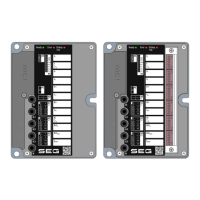7.15 Ipeak> – Peak-Value Overcurrent
7.15.1
Ipeak>: Device Planning Parameters
Ipeak> . Mode [Device planning / Projected Elements]
use “-”, use
╚═▷ Device planning
P.1
Peak-Value Overcurrent, general operation mode
Ipeak> . Denition [Device planning / Denition]
Trip Trip, Alarm
╚═▷ Denition
P.1
Peak-Value Overcurrent: If set to “Alarm”: The function operates as a supervision function, i.e. a fault generates
neither alarm nor trip, but an »Alarm« signal gets issued instead. If set to “Trip”: The function operates as a
protection function, i.e. trips the breaker in case of a fault.
7.15.2
Ipeak>: Settings
Ipeak> . Function [Protection Para / Ipeak>]
Active Inactive, Active
╚═▷ Mode
P.1
Permanent activation or deactivation of module/stage.
Ipeak> . I [Protection Para / Ipeak>]
8.0In 4.0In . . . 20.00In P.1
Pickup threshold, dened as RMS value (i.e. peak current value divided by √2). If the pickup value is exceeded, the
module/element starts to time out to trip.
Ipeak> . t [Protection Para / Ipeak>]
0.0s 0.00s . . . 5.00s P.1
Time delay for trip or alarm
Ipeak> . ExBlo [Protection Para / Ipeak>]
“-” “-” . . . Prot . Pos OFF
╚═▷
P.1
External blocking of the module if the state of the assigned signal is true.
62 WIC1 WIC1-1.0-EN-REF
7 Protection Parameter
7.15 Ipeak> – Peak-Value Overcurrent

